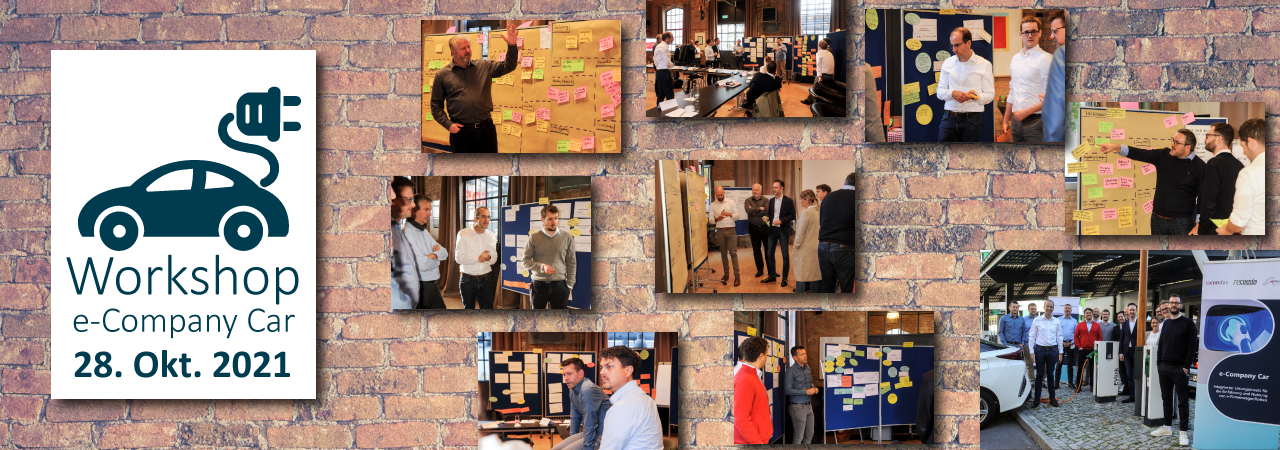Electrifying your fleet
How can companies start the electrification of their vehicle fleet? What partners need to be brought on board? How can they drive electrification forward efficiently and professionally? After intensive discussions about hurdles and pain points, the “e-Company Car” workshop series drew everything together last week in Berlin to answer these types of questions.
On October 28, acondas and its partner firms acterience and receeda conducted a workshop “e-Company Cars” at the EUREF campus in Berlin, in collaboration with 7 e-mobility experts from various companies. The outcomes include instruments and solutions for company fleet managers preparing to convert their fleets to full-electric vehicles in a profession manner.

Prior to this workshop, we had worked with industry experts and users for more than 1.5 years to analyse the pain points arising from introducing or using e-company cars and to develop first hypotheses for solutions.
Our workshop revealed a great breadth and depth of relevant topics. Some insights:
- Transparent total cost of ownership (TCO) in business plan: Converting from a conventional to a fully electrical fleet requires a major financial investment. The TCO includes higher purchase costs for fully electrical vehicles compared to gasoline engines, on-top costs for developing charging infrastructure (on site and at home) and the cost of additional services and administrative capacity. To prevent the fleet conversion from getting stuck midway, management needs full cost transparency in a long-term business plan. Be sure to update the business plan regularly to reflect technological advances and regulatory changes. The business plan should include a cost comparison between an e-fleet and a conventional fleet as well as the “break even” point when the investments in the e-fleet pay off.
- Bandwidths of new topics: Prior to introducing e-company cars, many different issues need to be clarified that go far beyond the daily business of a fleet manager, e.g.: expected driving and charging habits of firm car users, developing charging infrastructure (on site and at home), internal billing of charging cost, taxes, and subsidies, etc. Fleet management and administrative functions must be equipped to address and solve these issues or engage external partners to do so.
- Charging infrastructure: What type and capacity of charging infrastructure is required? Does every user need a private wall box? Should those be installed, maintained, and subsidized by the employer? These and many other issues related to on-site, private and public charging options need to be clarified before the first e-company car is acquired or leased. Our recommendation: Keep it simple! Identify a few (3-5) basic user groups with similar driving and charging habits and provide them with standardized packages of suitable vehicles and charging infrastructure.

- Billing charging costs: switching to e-company cars goes hand-in-hand with a new accounting topic: billing charging costs, including private electricity and potentially wall box costs, public charging costs, etc. We again recommend: keeping it simple. It is expected that all electric cars will have a plug-and-charge or autochargesystem within the next 5 years. The e-car itself will record kWh charging costs, including the type of charging infrastructure used, automatically transmitting such data to the (inhouse or external) accounting service provider. Until this target state is achieved, companies should implement simple workarounds for the most relevant standard types of charging.
- Change management: Converting from a conventional to a fully electrical fleet is a major change process. Sceptical company car users must be well informed and convinced of the advantages of e-cars, their fears about the transition assuaged, and success stories communicated. Early adopters and pilot users of e-company cars should have a platform to share their experiences and success stories.
- Fleet manager: e-company car adoption requires significant changes to the traditional fleet management role: The fleet manager will become a mobility manager with many new tasks and competencies. In addition to traditional fleet management skills, he or she will require assertive communication skills, technical expertise, such as on charging infrastructure, as well as the ability to build and maintain a network of internal and external experts. As long as the company fleet contains both e-cars and conventional cars, the capacity of fleet management needs to be expanded (internally and/or externally) to meet the additional administrative demands.

At first glance, converting a company car fleet from conventional to e-cars is a major effort. The good news: fleet managers can be supported and guided by internal functions and external experts. But it requires strong, well-informed proactive actions and committed management support.
If you are interested in further insights from our workshop, such as fleet management tasks, roles, competencies and instruments needed to successfully introduce and operate a fleet of e-company cars, please reach out to us: info@acondas.com (keyword “e-company cars”).
